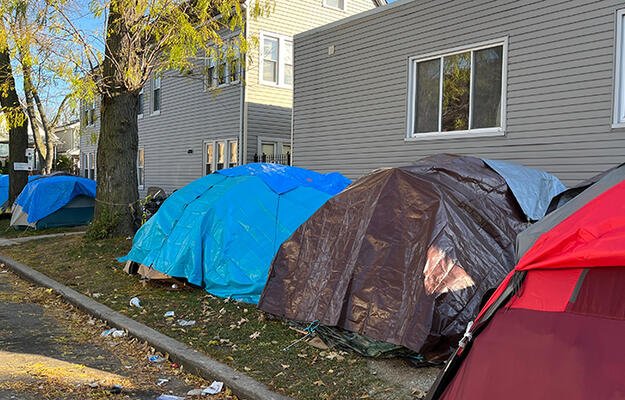
Three Ways Community Land Trusts Support Renters
by Kimberly Burrowes
From childhood through retirement, stability and roots in a community are a source of well-being. Yet, attaining and sustaining this stability can be challenging—especially for the lowest-income renter families. In fact, for every 100 renter households in the lowest income bracket, only 21 homes are affordable. Community Land Trusts (CLTs) can play a role in the solution.
CLTs are nonprofit, community-based organizations that steward land for specific community purposes. They are used to expand and preserve low- and moderate-cost housing, sustain commercial and civic assets, and foster neighborhood engagement through stewardship of the land. Although typically used as an approach for shared equity homeownership, CLTs can also stabilize housing access, increase affordability, revitalize properties in disinvested communities, and enable renters to participate in community governance processes.
According to membership data provided by Grounded Solutions Network, the 148 CLTs in their network held the land for 9,434 rental homes by the end of 2017. This compares with 14,795 cooperative units, 8,024 owned homes, and 166 lease-purchase homes. Rental homes are a core part of the CLT approach. The largest CLT in the United States, Champlain Housing Trust in Burlington, Vermont, has 2,200 rental units—three times more than the number of units they manage for homeownership.
As more communities consider the CLT model as a way to provide affordable access to housing, understanding its role for renters will improve social equity. But the success of CLTs hinges on active community support, local leadership, and sustained buy-in from residents and the surrounding community.
Here are three ways CLTs can benefit renters.
- CLTs add affordability for renters.
Data show the need for affordable rental housing is far greater than the supply. Though federal rental assistance narrows the gap in the affordable supply, just one in five eligible households who needs assistance gets it. Affordability challenges have risen to the national agenda and are a pressing local issue in cities like Austin, Denver, and Seattle, where median rents are rising twice as fast as other US cities.
CLTs use long-term land leases to lower costs for rental housing providers (or owner occupants) in exchange for long-term affordability restrictions. The model can enable nonprofits to produce new housing with low or moderate rents or preserve rental affordability despite rising market demand. By reducing constant financial pressure, CLTs enable renters to use their income in more productive ways, such as spending on other current needs or saving for future goals.
Amid increased development in the Eastern North neighborhood of Philadelphia, residents wary of rising housing costs and displacement created the Community Justice Land Trust to stabilize costs and ensure the existing residents—especially renters—could stay. Their holdings include rent-to-own homes, with an expected addition of rental townhomes. In New York City, residents and the local government created the Cooper Square CLT to maintain multifamily rental options in a market with high and rising costs. The CLT has focused on both housing development and community organizing to ensure people can stay there.
- CLTs revitalize housing in communities struggling with disinvestment.
Reconnecting vacant properties to the housing market as rental homes can bring both economic and social benefits. In communities with high vacancy rates and physically distressed properties, CLTs can purchase and renovate these properties. Revitalizing the built environment supports the well-being of nearby residents. Chances are good that local residents in a distressed area are a mix of renters and low-income owners—and are disproportionately people of color. When CLTs adopt a revitalization strategy that includes new below-market rental housing, the effort both supports improved well-being and ensures that the community remains affordable to lower-income renters, even as property values rise.
For instance, the Dudley Street Neighborhood Initiative in Boston rehabilitated 600 vacant lots to create a more vibrant community while remaining affordable for renters. The CLT transformed the Dudley Street neighborhood, which was characterized as mostly vacant, with arson and dumping problems. Additionally, CLTs can boost social perceptions of a place. A CLT in Athens, Georgia, uses low-income housing tax credits and funds from the federal HOME and Community Development Block Grant programs to deliver affordable rental housing.
- CLTs provide community representation and renter initiatives.
Beyond generating long-term affordability in communities, CLTs empower renters as decisionmakers in their neighborhoods. Although the idea of a neighborhood association may evoke the idea of homeowners working collectively to increase property values, the governance of CLTs may have a shared governance structure with homeowners, renters, and representatives from the surrounding community, such as elected officials, philanthropies, and nonprofits. The Athens Land Trust notes the role of CLTs in restoring power as a means of disrupting the effects of sharecropping for black communities in the state.
In North Carolina, the renter engagement work of the Durham Community Land Trustees (DCLT) has led to partnerships and initiatives that help renters make economic progress. For example, DCLT launched a program with the Community Empowerment Fund and the City of Durham to help renters build credit through their monthly payments while preventing them from taking on additional debt.
Photo by Matthew Henry/Unsplash


